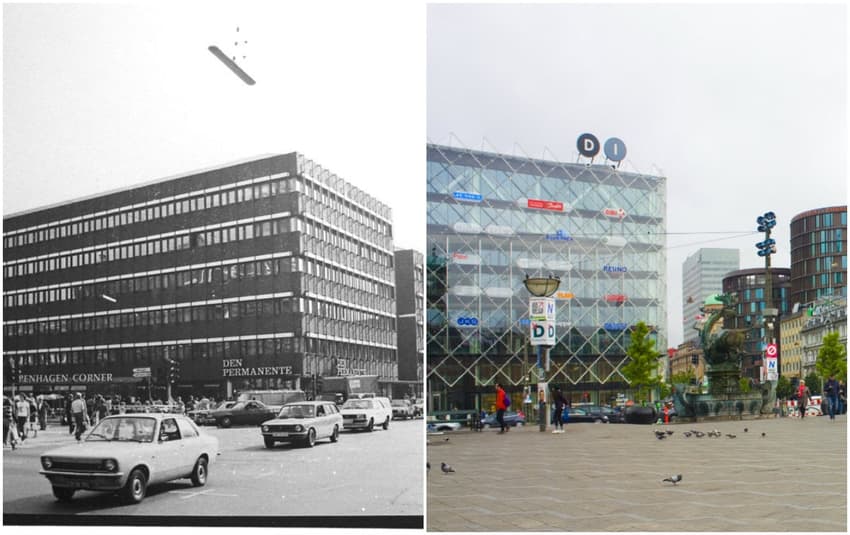Denmark in the 1980s in pictures – and the same locations today

We've been combing the archives again to find historical photos of Denmark from the 1980s.
You can see the photos below and compare them with how the locations look today.
READ ALSO:
-
Photos of Denmark in the 1970s – and how the same places look today
-
10 photos of Denmark in the 1950s and 1960s – and the same spots today
Industriens Hus, Copenhagen, 1980
The building on the busy corner opposite Copenhagen's City Hall Square has been replaced a number of times of over the years.

Photo: Henning Thempler / Ritzau Scanpix
Protest, 1986
Former prime minister Anker Jørgensen stands outside the United States Embassy in Copenhagen giving a speech in protest at nuclear testing at the Bikini Islands.

Photo: Mogens Ladegaard / Ritzau Scanpix
Pub, 1980
Frederiksberg's Vinstue 90 almost 40 years ago.

Photo: Erik Holmberg / Ritzau Scanpix
Nørreport Station, Copenhagen, 1980
The air vents can be recognized in this old picture of Nørreport Station, but much of the area has been rebuilt.

Photo: Steen Jacobsen / Ritzau Scanpix
Cyclists, 1980
Cyclists on their way to a protest at Christiansborg in central Copenhagen.

Photo: Mogens Ladegaard / Ritzau Scanpix
Christiania, 1989
A police raid at anarchist enclave Christiania.

Photo: Claus Bjørn Larsen / Ritzau Scanpix
Printers' action, 1981
Print workers demonstrate at the offices of Fyns Amts Avis, Svendborg, 1981.

Photo: Ritzau Scanpix
Aarhus, 1985
The rail terminal in Aarhus as it appeared in the mid '80s. The angle is somewhat different in the Google image.

Photo: Erik Jepsen / NF / Ritzau Scanpix
Porn shop, Vesterbro, Copenhagen, 1980
A shop which once sold pornographic movies is now a vintage clothing store.

Photo: Henning Thempler / Ritzau Scanpix
READ ALSO: Ten historic pictures that show life in Denmark decades ago
Comments
See Also
You can see the photos below and compare them with how the locations look today.
READ ALSO:
- Photos of Denmark in the 1970s – and how the same places look today
- 10 photos of Denmark in the 1950s and 1960s – and the same spots today
Industriens Hus, Copenhagen, 1980
The building on the busy corner opposite Copenhagen's City Hall Square has been replaced a number of times of over the years.

Photo: Henning Thempler / Ritzau Scanpix
Protest, 1986
Former prime minister Anker Jørgensen stands outside the United States Embassy in Copenhagen giving a speech in protest at nuclear testing at the Bikini Islands.

Photo: Mogens Ladegaard / Ritzau Scanpix
Pub, 1980
Frederiksberg's Vinstue 90 almost 40 years ago.

Photo: Erik Holmberg / Ritzau Scanpix
Nørreport Station, Copenhagen, 1980
The air vents can be recognized in this old picture of Nørreport Station, but much of the area has been rebuilt.

Photo: Steen Jacobsen / Ritzau Scanpix
Cyclists, 1980
Cyclists on their way to a protest at Christiansborg in central Copenhagen.

Photo: Mogens Ladegaard / Ritzau Scanpix
Christiania, 1989
A police raid at anarchist enclave Christiania.

Photo: Claus Bjørn Larsen / Ritzau Scanpix
Printers' action, 1981
Print workers demonstrate at the offices of Fyns Amts Avis, Svendborg, 1981.

Photo: Ritzau Scanpix
Aarhus, 1985
The rail terminal in Aarhus as it appeared in the mid '80s. The angle is somewhat different in the Google image.

Photo: Erik Jepsen / NF / Ritzau Scanpix
Porn shop, Vesterbro, Copenhagen, 1980
A shop which once sold pornographic movies is now a vintage clothing store.

Photo: Henning Thempler / Ritzau Scanpix
READ ALSO: Ten historic pictures that show life in Denmark decades ago
Join the conversation in our comments section below. Share your own views and experience and if you have a question or suggestion for our journalists then email us at [email protected].
Please keep comments civil, constructive and on topic – and make sure to read our terms of use before getting involved.
Please log in here to leave a comment.